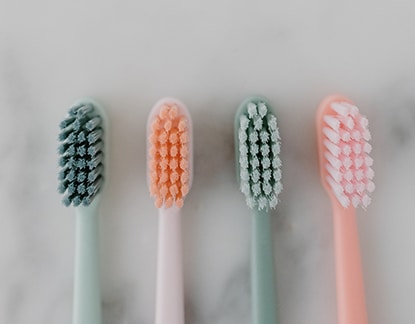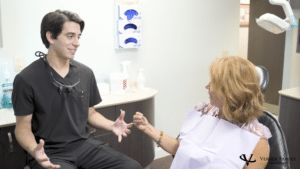If you follow the dentist’s recommended regimen of brushing twice a day, your toothbrush has certainly taken a beating. While your mouth may be becoming cleaner, unless you thoroughly disinfect your toothbrush each time, it will gather the remains of bacteria. It is important to take care of your toothbrush. We will provide you with the information to know how to help lessen and prevent toothbrush wear, how to clean a toothbrush properly, and when it’s time to get a new toothbrush or toothbrush head.
Protecting Your Toothbrush from Bacteria:
Before we jump in on how to clean your toothbrush after use, there are a few ways you can help prevent the bacteria from even getting there in the first place.
- Keep a headcover with slight breathing room for your brush.
- You don’t want it fully enclosed or the possibility of mold can develop. Wash the cover you use semi-regularly so that germs from the cover don’t transfer to the toothbrush.
- Don’t keep multiple brushes in the same container.
- Especially if it’s with other people’s brushes, as the germs from each other’s brushes can come in contact with one another causing cross-contamination. Also, do not share toothbrushes with people. The bacteria that causes tooth decay and cavities is actually infectious, so think twice before sharing.
- Keep the brush away from your toilet.
- Toilets disperse fecal matter every time they are flushed. These particles travel in the air and can easily make it onto your brush if too close.
- Store your toothbrush in an upright position out in the open to let it air dry.
- When in enclosed spaces bacteria are able to thrive due to the absence of air.
- Don’t brush too hard.
- A harder brush is not a better brush, it can actually be worse if you are too aggressive with your brushing. Not only does it make the toothbrush wear out faster, it can also wear down your tooth enamel.
Keeping Your Toothbrush Clean:
To get rid of the bacteria that lingers on your toothbrush after use, there are a few common methods you can use.
- Hot Water – The most common and simple way to rid your toothbrush of bacteria is to run it thoroughly underwater, specifically in hot water. Hot water breaks down bacteria much more easily than cool or cold water does. This method works for the majority of people. Be sure to not have too high of water pressure when rinsing the brush so as to not damage it.
- Mouthwash – One method that may give you better peace of mind is soaking your brush in mouthwash until the next use. This method can, however, be problematic because there are chemicals in mouthwash that can break down the brush faster than just rinsing normally.
- Tooth Brush Sanitizer Solution – There are reliable toothbrush sanitizers that work if you feel that you need an extra method of protection against germs or feel that you did not store your toothbrush properly and want to continue using it.
When To Switch Toothbrushes
So, when is it time to give up on your toothbrush? The average time for a toothbrush to reach its lifecycle is around 3 to 4 months. This includes the heads on electric toothbrushes. You will be able to tell when it will need to be replaced once the bristles become worn and damaged. It is important to make the switch to a new toothbrush because once one becomes aged enough its effectiveness drastically decreases.





